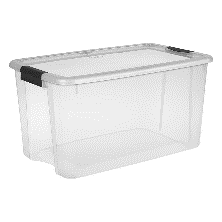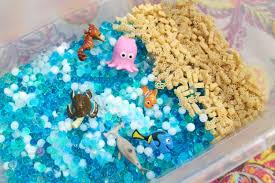Sensory Bins: What You Need to Know
news-article
January 29, 2020
Written by: Stefanie Larsen, OTR/L,Spaulding Outpatient Center for Children in Lexington
What are Sensory Bins?
 Sensory bins are hands-on tactile experiences for kids, playing with a variety of mediums in controlled containers. They are easy and inexpensive to create and a great way for children to develop a variety of skills such as fine motor skills, motor planning, visual motor skills, tactile exposure, play skills, socials skills and language.
Sensory bins are hands-on tactile experiences for kids, playing with a variety of mediums in controlled containers. They are easy and inexpensive to create and a great way for children to develop a variety of skills such as fine motor skills, motor planning, visual motor skills, tactile exposure, play skills, socials skills and language.
How to Make a Sensory Bin:
- Containers: Sensory bins work in a variety of containers. Deeper containers may be better for older children and more fine fillers such as rice and popcorn to contain the small pieces. Long, narrow containers may be better for younger children with larger fillers such as beans, aquarium rocks and confetti. You can also use small children’s plastic or inflatable pools for a giant indoor or outdoor sensory bin.
- Fillers: The choices for fillers are endless! Rice, kinetic sand, beans, dry pasta, foam letters, foam stickers, cut up pool noodles, water, confetti paper, aquarium rocks, water beads, popcorn, snow, and poms-poms. If you have younger children or children who still mouth items, you want to keep that in mind when picking your filler. In those situations, I tend to prefer rice (small, not a choking hazard and can be eaten). Other taste safe or edible fillers include: oatmeal, cereals, and tapioca pearls (a safe water beads alternative).
- Other Tools: Additionally, a variety of scoopers, tongs, tweezers, cups, bowls and strainers are helpful as tools in sensory bins. Hiding small animal figures, puzzle pieces that children have to find and then assemble together, magnetic letters to put together words, stress/fidget balls or any items that are motivational to the children.
TIPS:
- What about the mess?! There are a few ways to contain the mess. Put a large sheet, shower curtain liner or painters drop cloth under the box for easy clean up. You can also put a small sensory bin in a large under the bed bin to help catch overflow. Also, if your child becomes too messy, stop the play and resume again at another time.
 How to extend the play: Have your child search for various objects in the bins, play “I Spy,” find and sort objects by color or categories. Make a car wash with soap and bubbles and wash trucks or cars. Have cars drive in the sand. Build sand castles. Make a multi-sensory bin with one side with a dry material (beans) and one side wet (water). The possibilities are endless!
How to extend the play: Have your child search for various objects in the bins, play “I Spy,” find and sort objects by color or categories. Make a car wash with soap and bubbles and wash trucks or cars. Have cars drive in the sand. Build sand castles. Make a multi-sensory bin with one side with a dry material (beans) and one side wet (water). The possibilities are endless!
Be Creative and Have Fun!
For more information on sensory needs or to schedule an occupational therapy evaluation at Spaulding Outpatient Center for Children in Lexington, please contact our front desk at 781-860-1742.
